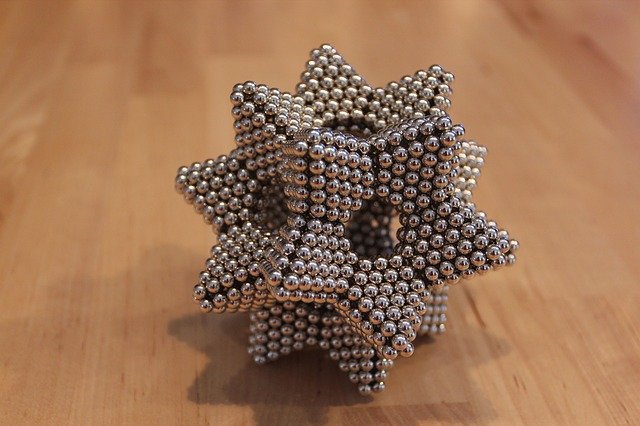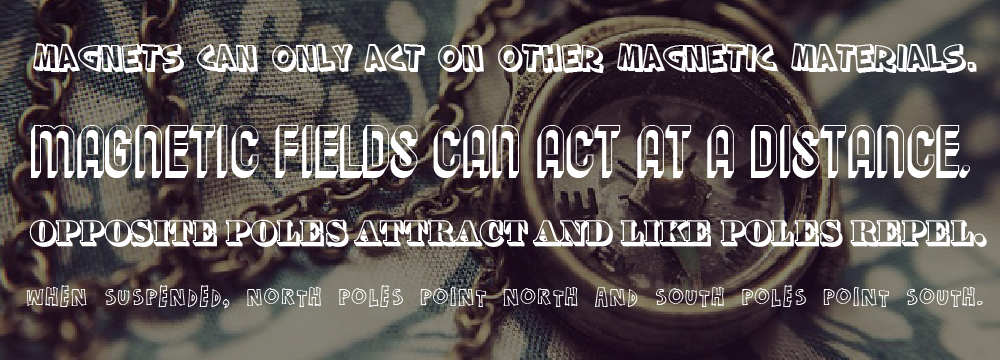Session 1 – Introduction
What is a magnet?
A magnet is a material or object that produces a magnetic field. This magnetic field is an invisible force that pulls on other ferromagnetic materials, such as iron, and attracts or repels other magnets.
A permanent magnet is one that retains its magnetic properties for a long period of time. A temporary magnet only maintains its magnetism while in the magnetic field produced by a permanent magnet.
What would your world be without magnets?
What about Magnetism?
- Magnetism was first discovered in the ancient world, when people noticed that lodestones, naturally magnetized pieces of the mineral magnetite, could attract iron.

Magnetite - The word magnet comes from the Greek term “the Magnesian stone, lodestone.”
- In ancient India, magnets were used for for surgery.
- The Ancient Chinese used magnetite to develop north-south pointing devices as early as 200 B.C.
- Court magicians entertained royalty using magnetic spoons that would always point in the same direction.
- In England, these rocks were called lodestone (lode meaning to guide).
The Properties of Magnets.
With these observations, European sailors were able to navigate using needles that were magnetized by lodestone. Their north-south orientation was used for navigation, though the Chinese used these stones to create compasses a few centuries earlier.
Session 2 – Experiment
Make a Compass.
Purpose:
I wonder what will happen if we float a temporary magnet (needle) in water?
Hypothesis:
I think it will point North-South to the Earth’s magnetic poles.
Materials:
- sewing needle
- plastic straw
- bowl of water
- magnet
Procedure:
- Fill a bowl with water.
- Attach a sewing needle to a section of straw.
- Magnetize the sewing needle. Do this by stroking the needle with a magnet from eye to tip 30 times. Make sure to stroke it in the same direction each time.
- Float the magnetized needle very carefully on the surface of the water.
Explanation:
The needle will point North-South. Check it with a compass.
Every magnet has a north-seeking and south-seeking pole. If two magnets are brought together, the north pole of one will attract the south pole of the other. This is why compasses work on the Earth. The Earth’s magnetic field, although weak, is strong enough to make the north pole of a free floating magnet align with the magnetic pole of the planet.
Write Up.
Session 3 – The Earth
Earth’s Magnetic Field
The Earth is like a giant magnet in several ways. Not only does it have a magnetic north and south pole that act similarly to the poles on bar magnets, but the planet is surrounded by a strong magnetic field, which is electrically charged and able to interact with magnetized matter.
Earth’s magnetic field, is also known as the geomagnetic field, is the magnetic field that extends from the Earth’s interior out into space.
In space it meets the solar wind emanating from the Sun.
The North geomagnetic pole, located near Greenland in the northern hemisphere, is actually the south pole of the Earth’s magnetic field.
The South geomagnetic pole is the north pole.
The magnetic field is generated by molten iron in the Earth’s outer core.
Sea Turtles Guided Home by Magnetic Sense
Session 4 – Experiment
Iron Filings
Iron filings are very small pieces of iron that look like a light powder. They are very often used in science demonstrations to show the direction of a magnetic field.
Purpose:
I wonder what will happen if I use the force of a magnet on iron filings?
Hypothesis:
I think the magnet will attract the iron filings.
Write Up.
Session 5 – Experiment
FerroFluid
A ferrofluid is a liquid that becomes strongly magnetized in the presence of a magnetic field.
The term ‘ferrofluid’ is a portmanteau of ferromagnetic and fluid and is used to describe a fluid that is strongly magnetized by a magnetic field.
The most common minerals used in making these magnetic particles are iron oxides such as magnetite (Fe3O4) and hematite (Fe2O3).
Purpose:
I wonder what will happen if I pour ferrofluid over a temporary magnet which is held in place by a permanent magnet?
Hypothesis:
I think it will be affected by the permanent magnet.
Write Up.
Session 6 – Experiment
Make a Homopolar Motor.
A homopolar motor is a device that converts a magnetic field and a direct electrical current (DC) into motion. The motor rotates due to the effects of the current passing through the magnetic field.
Scientist Michael Faraday first demonstrated the effect in 1821 with a wire rotating around a magnet in a mercury bath.
Photo Report.
Make your homopolar motor and take a bunch of photos to make a photo report. Present this however you choose.
Session 7 – Wrap Up!


